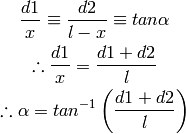Table of Contents
| Name | Direction | Type | Default | Description |
|---|---|---|---|---|
| Workspace | Input | MatrixWorkspace | Mandatory | Workspace to calculate the instrument resolution of. |
| TwoTheta | Input | number | Optional | Two theta scattering angle in degrees. |
| FirstSlitName | Input | string | slit1 | Component name of the first slit. |
| SecondSlitName | Input | string | slit2 | Component name of the second slit. |
| VerticalGapParameter | Input | string | vertical gap | Parameter the vertical gap of each slit can be found in. |
| TwoThetaLogName | Input | string | Theta | Name two theta can be found in the run log as. |
| Resolution | Output | number | Calculated resolution (dq/q). | |
| TwoThetaOut | Output | number | Two theta scattering angle in degrees. |
This algorithm takes a workspace and a value for two theta, and attempts to calculate the reflectometry resolution (dQ/Q) from them. If no value is provided for two theta then CalculateResolution will attempt to fetch a value from the workspace’s log using the two theta log name provided.
CalculateResolution outputs two values, the calculated resolution and the value of TwoTheta that was used in the calculation. The latter is useful when TwoTheta was not given to CalculateResolution, causing CalculateResolution to extract it from the workspace’s sample log.
The effective inverse of this algorithm is CalculateSlits v1.
Proof

where  gives is the beam divergence in radians. Parameter d1 is the vertical distance of Slit1 opening, d2 is the same for Slit2. parameter l is the distance between the slits in the beam direction. See figure above for
reference.
gives is the beam divergence in radians. Parameter d1 is the vertical distance of Slit1 opening, d2 is the same for Slit2. parameter l is the distance between the slits in the beam direction. See figure above for
reference.
ws = Load('INTER00013460')
res, two_theta = CalculateResolution(Workspace = ws, TwoTheta = 0.7)
print("Resolution: %.4f" % res)
print("Two Theta: %.4f" % two_theta)
Resolution: 0.0340
Two Theta: 0.7000
Categories: Algorithms | Reflectometry\ISIS